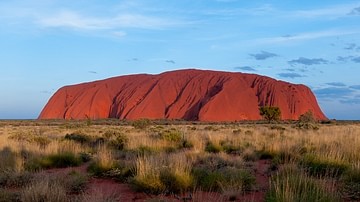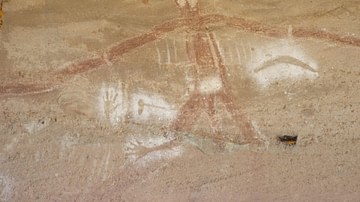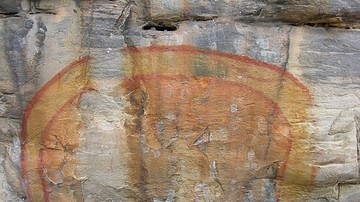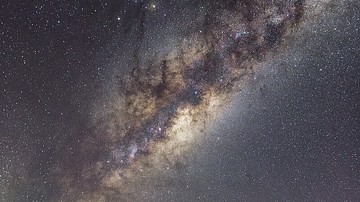
Dreamtime (The Dreaming) is the English term used to describe the mythology and spirituality of Indigenous Australians. It is a philosophy, worldview, cosmology, and way of life that explains how the world was created. Although people often associate dreams with Dreamtime, it encompasses much more than that.
The Dreaming is an expansive consciousness that deals with everything from the meaning of life to everything in between. Indigenous Australians differentiate between ordinary dreams and more spiritual ones associated with Dreamtime.
The myths of Dreamtime have been passed down orally for thousands of years and are conveyed through song, storytelling, dance, and art. These myths gave each individual wisdom and purpose. The Dreaming did not take place in the past but is always present in a parallel timeline that continues to nurture the earth. Time and place are infinite in Dreamtime. Indigenous Australians believe that their lives had already been predestined by the spiritual beings of Dreamtime and that it is their duty to live in accordance with those terms.
The Aboriginal Australians & the Land
Aboriginal Australians are made up of various indigenous groups that first arrived in Australia from Asia around 65,000 years ago. They inhabited mainland Australia and its many islands. Each group had its own unique language, traditions, and culture, including different gods and creation stories. Places in modern Australia are tied to specific Indigenous Australian groups; for example, Sydney is the home of the Eora nation, while Melbourne is home to the Wurundjeri people.
Knowledge is not freely available in Indigenous Australian culture and is based on age, gender, and clan membership. Some languages are only spoken by females, and vice versa. There are strict guidelines for everything, including religious ceremonies, land rights, and social relationships.
Indigenous Australians view themselves as custodians of the land rather than its owners. The land is an integral part of Dreamtime, with every aspect of the Australian land carrying signs of the ancestral beings and magic. The grey clouds, the emerald water of the lakes and rivers, and the redness of the dust and rocks all carry elemental qualities. The running waters of the stream remind us of the Rainbow Serpent, who created the streams with her burrowing body. The rock cairns signify the All-Father spirit, Baiame (Biame), who came down from the sky with his sacred law, while the bonfires are reminiscent of the original fire lit by the Sun Mother's hands, and a landslide may tell of a violent battle.
Although the whole land is sacred to Indigenous Australians, some parts are more special or powerful than others. These include Uluru (Ayers Rock), Kata Tjuta (the Olgas), and the waters of Kununurra. These are some of the places where the energy of the ancestral spirits is more concentrated due to their association with Dreamtime stories.
The power of the land can be seen in the stories once told about the Nimbin Rocks in New South Wales. Supposedly, a high percentage of women who lived in the vicinity of the Nimbin Rocks suffered miscarriages. They approached an Aboriginal elder, who informed them that Nimbin Rocks was traditionally a male site and women were not supposed to visit. These women moved away from the proximity of the rocks and went on to have successful pregnancies.
Space
Indigenous Australians also believe that space was formed during Dreamtime. The eclipse is described as the Sun coupling with her consort. The Milky Way was created when the serpent spirit pulled down a tree and sent twinkling fireflies into the darkness of the night. The Southern Cross constellation was formed when a possum climbed a tree, got stuck, and became a celestial marking, while the Sagittarius constellation resembles spears being held up to the sky by angry spirits. Indigenous Australians use the night sky and constellations as a guide to physical locations and tribal boundaries.
Animals
Tales about animals form the majority of Dreamtime stories, with the most famous animal story being that of the Rainbow Serpent, who is viewed as a creator deity. In Dreamtime, animals are both creatures and humans. They have the same characteristics as animals (fur and tails) but also do human things like speaking and using spears for hunting. Some tales explain why animals have certain human characteristics, while others recount how the animals we know today evolved from human forms.
Some of the best-known Dreamtime stories about animals include:
- The Rainbow Serpent
- Boora the Pelican
- How the Kangaroo Got Its Tail
- The Rainbird
- How the Koala Lost Its Tail
- Weedah the Mockingbird
- How the Turtle Got Its Shell
- How the Platypus Came to Be
- Tiddalick the Greedy Frog
- How the Birds Got Their Colours
- The Lizard Women
- The Giant Frog
- The White Dingo
- How Swans Became Black
- Beware of the Bunyip!
Songlines
Songlines, also known as 'Dreaming Tracks', are energy lines that are found across Australia and are regarded as a 'knowledge system'. It was an idea that was made popular in the 1980s by English travel writer Bruce Chatwin (1940-1989), who spent time in Australia learning more about Indigenous Australian beliefs and traditions. Songlines are the routes that Dreamtime beings took across the earth and sky and can be visualised as pathways of knowledge. The beings named everything they encountered and left marks. Some of these ancestral beings returned to the heavens, while others turned to stone, where they can still be seen today.
The songlines are associated with animals (mostly native), natural elements (water), and modern events (natural disasters). If someone sings the hero's song in the correct sequence and follows in the footsteps of the supreme beings, they can travel long distances without getting lost. The songs describe the geographical landscape and can even lead an individual to where to find food in the wild. Therefore, they are not only navigational tools but also survival guides. Indigenous people learn these maps through songs and stories. However, different factors (age and gender) determine whether someone can access the entire Dreaming track or only parts of it.
Songlines cover the vast Australian continent; some are longer than others and flow in specific directions. It could be considered sacrilegious if someone walked the wrong way along a songline. Certain songlines may be sung in different languages as they cover the land of several nations. However, the song's rhythm helps travellers stay on the right track.
The Country
Where an Indigenous Australian nation lives impacts its Dreamtime stories. For example, Indigenous Australian tribes who live by the sea or ocean have stories featuring creatures like dolphins, turtles, and saltwater crocodiles, while the stories of people who live in the desert or bush feature dingoes, kangaroos, and emus. The dugong is sacred to the Torres Strait Islander communities of Northern Australia, so their stories highlight the dugong's travels from island to island.
The vast Australian landscape and the many Indigenous Australian nations all add to the rich and diverse stories of Dreamtime.
Communicating with the Land
Indigenous Australians believe that the land must be sung to (Yorro Yorro) to keep it alive, and it must also be closely listened to (Dadirri) and observed. Singing to the land (Yorro Yorro) is integral to keeping wildlife alive and renewing nature as it maintains harmony. The songs sung are of the heroic deeds and journeys of the ancestral beings. Some are short, while others are so long that they can take days to sing. Elders may dream about a new part of a song that will then be added to the songline. Pairing these songs with sacred dances has a powerful, positive force on the land.
Listening to the land (Dadirri) is also another way of staying connected to the land. Indigenous people believe that the land speaks to us. Different Indigenous Australian nations have their own ways of listening to the land, such as meditation and deep breathing. Indigenous Australians are taught to look at the earth with their third eye and look for signs from the spirit world. For example, a perfectly healthy-looking tree falling down suddenly can be a spiritual sign.
Key Figures of The Dreaming
Like all other world mythologies and religions, some key figures (Great Spirits) are better known and held in higher esteem than others. Note that the names of the Great Spirits, deities, and their powers can differ from nation to nation and tribe to tribe.
- Baiame (Byamee): the creator spirit who created earth and humanity. He is the incarnation of care and kindness. As a sign of his love, he elevated one of his wives, Birrahgnooloo, to live alongside him in the sky and described her as the Mother-of-All.
- Yhi (Yarai): the goddess of the sun who provided light and warmth to Baiame's world. Yhi is the female counterpart of Baiame.
- Punjel: another father spirit, who is subordinate to Baiame
- Bahloo: the moon god
- Marmoo: the spirit of evil
- Bunjil: a creator deity sacred to the Kulin people of Central Victoria
- Binbeal: a spirit associated with the rainbow, the son of Bunjil
- The Rainbow Serpent: undoubtedly one of the best-known ancestral spirits in the Dreamtime. The Rainbow Serpent is the spirit of water, floods, and rain. Many Aboriginal tribes believe that the earth will dry up and life will cease to exist without the Rainbow Serpent.
Dreamtime Today
The belief system of modern-day Indigenous Australians is impacted by their traditional beliefs, European-introduced religions, Australia's dark colonial past, and current events. However, they continue to have strong ties with the land and their heritage.
Dancing, stories, traditional dot paintings (Papunya Tula), and songlines continue to impart wisdom and invaluable lessons about the land and Dreamtime. Modern media content like films, TV shows, and books also play a part in educating Australians and the world about the historical and spiritual importance of Dreamtime.
Author's note: This author acknowledges the Traditional Owners of the land on which she writes. She would also like to pay her respects to Elders past, emerging, and present.












